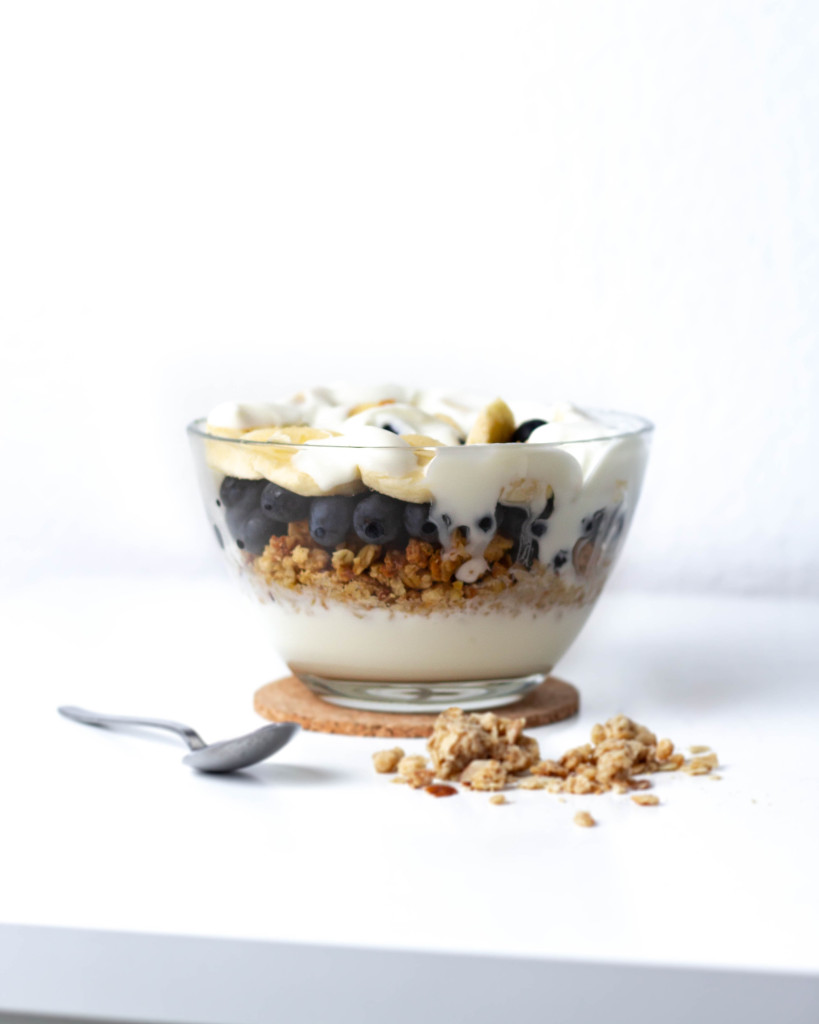
What Does it Mean to Have Poor Gut Health or Gut Dysbiosis?
Trillions of living microbes inhabiting your body? That might sound creepy, but you wouldn’t be alive without these living organisms! They can be found living on your skin, mouth, nose, and primarily in the small and large intestines.
Exactly how many trillions of microbes the gut hosts is debatable. Whereas earlier estimates argued these microbes outnumber human cells 10 times, newer research shows that number is smaller but still in the trillions. Collectively, we call this microbial community the microbiome.
Everyone’s microbiome is unique, initially determined by your DNA. By around age three years old, the gut microbiome becomes stable and is largely determined by three early life factors: mode of delivery, breastfeeding or bottle feeding, and use or absence of antibiotics. Newborns delivered vaginally will have a different microbe composition compared with babies delivered via C-section. After you’re born, the nutrient intake – from your mother’s breast milk will impact the composition and diversity of those microbes.
As you grow older, things like your environment and your diet can largely impact the microbiome. Even your geographical location – what country you live in and whether you live in a rural or metropolitan area – can influence microbiota diversity!
When I refer to the microbiome or trillions of microbes, I’m referring to the thousands of different species that include bacteria, fungi, parasites, and viruses. Altogether, these microbes support your immune system and metabolism, help the body detoxify, protect against autoimmune diseases, and so much more.
One thing that numerous studies have made clear: The gut is the center of health. The gut composition in your microbiome can influence whether you have food sensitivities, bloating from onions and garlic, heartburn from apple cider vinegar, asthma, an abdominal balloon after you eat, higher levels of anxiety, and so much more!
Beyond Digestion: The Many Roles of the Gut
The trillions of microbes that inhabit the gut help extract energy and nutrients from food, They help break down potentially toxic food compounds. Gut microbes also synthesize vitamins and amino acids, including B vitamins and vitamin K.
Microbes in the colon also produce short-chain fatty acids (SCFA) from dietary fiber. Fiber travels undigested until it reaches the large intestine, where specific microbes ferment it. The three SCFAs that microbes ferment – acetate, propionate, and butyrate – are the primary fuel of colon cells.
Clinical trials have shown that SCFAs support gut-related conditions including ulcerative colitis, Crohn's disease, and antibiotic-associated diarrhea. SCFAs might also play a key role in preventing or managing conditions such as metabolic syndrome (blood sugar, metabolism and heart health) and certain types of cancer.
The benefits of SCFAs reflect how the gut, with its trillions of inhabited microbes, is far more than just a digestive organ. It has so many important responsibilities! Among other examples of how the gut interacts throughout the body:
- Microbes help the gut perform like a second brain. The gut-brain axis can impact your mood, your risk for dementia, and much more.
- Gut microbes produce neurotransmitters such as gamma-aminobutyric acid (GABA), which regulates feelings such as anxiety. About 90 percent of your serotonin, your feel-good serotonin is synthesized there. The gut contains about 400 times more melatonin, which regulates circadian rhythm, than the pineal gland.
- Microbes play key roles in many hormones. The estrobolome, for instance, refers to the gut’s metabolism of estrogen. I’ve written more about estrogen and what happens when it becomes out of balance here.
- About 70 percent of your immune system, called the gut-associated lymphoid tissue (GALT), exists within the gut. Specific gut microbes can “train” immune cells called T cells to fend off attackers that can harm the body.
- Even the liver becomes susceptible to diseases such as inflammation, fibrosis, and cancer when imbalances occur with gut microbes.
Most of the microbes that inhabit the gut are helpful, but there are some that can be more harmful. Even so, “good” and “bad” microbes can coexist peacefully and a range of diversity allows microbes to perform their specific duties and contribute to a healthy ecosystem.
Symbiosis means “living in harmony with.” When the microbes that inhabit the gut are symbiotic, they exist in the right balance, which benefits many aspects of your health. You give these microbes a home. In turn, microbes support a healthy human body by regulating the immune system, promoting a healthy gut barrier and protecting against pathogenic microbes.
Dysbiosis: When the Gut Falls Out of Balance
When the balance of these trillions of gut microbes becomes disrupted, a condition called dysbiosis occurs. Dysbiosis can happen in any area that has a mucosal or barrier surface but here I will be referring to gut dysbiosis. With dysbiosis, the gut ecosystem has lost its balance, which means that it no longer can maintain a healthy balance with the rest of the body.
Dysbiosis can commonly trigger a host of symptoms that may leave you feeling like a hot mess, such as:
- Gas
- Bloating
- Diarrhea and/or constipation
- Indigestion or acid reflux
- Abdominal pain
The symptoms of dysbiosis go beyond the gut, however, to include rashes, hives, and eczema, asthma, nerve pain or numbness in your hands and feet, joint swelling, sinus inflammation, migraines, allergies, and more. It’s difficult for many to connect their extraintestinal symptoms to their gut microbiome but dysbiosis is an extremely common trigger.
In my practice, I often see dysbiosis result in other problems in the gut and beyond. For some people, dysbiosis can manifest as a bacterial overgrowth or also a yeast overgrowth that leads to candidiasis. Candida is typically a healthy fungus. When it overgrows in the intestine, this overgrowth can damage the gut wall, leading to other gut issues like leaky gut and allowing toxins to slip into the bloodstream. Over time, candida overgrowth and other forms of dysbiosis can lead to symptoms that might not seem related to gut health.
What Causes Dysbiosis?
Genetics can absolutely impact the balance of gut microbes. However, many things that you are exposed to in your environment have a far more significant impact. So many things in modern life can disturb that balance and generally gut dysbiosis is not created by one trigger but rather, several. Consuming too much alcohol, exposure to pesticides, cigarette smoking, and sleep disruptions can all impact the quantity and quality of gut microbes. In my practice, I see three primary factors that are most likely to drive dysbiosis:
- Chronic stress. Feeling constantly stressed can decrease microbe diversity, so you have fewer good microbes including Lactobacilli and Bifidobacteria. Stress can also increase the growth of harmful microbes. I talk more about stress and the gut response here.
- Antibiotics. The CDC estimates that 30% of antibiotics prescribed in outpatient settings are unnecessary. That’s 47 million excess prescriptions that are not effective for common cold, sinus and ear infections, bronchitis and more. If you have been taking a Z-pack daily for a few months every year, this is something to discuss with your doctor! Every time you take a round of broad spectrum antibiotics, they wipe out all microbes, good and bad. They do not distinguish between good and bad bacteria. In fact, antibiotics are thought to be the number one cause of dysbiosis. In one study, every disease in the cluster of chronic diseases – cardiovascular disease, obesity, diabetes, urinary stone disease, asthma, and inflammatory bowel disease (IBD) – showed a statistically significant association with using antibiotics over the previous year. In other words, the dysbiosis that resulted from antibiotics was a potential contributor to these diseases. Equally concerning, using antibiotics had a statistically significant association with the composition of these gut microbes up to one year after use.
- Diet. What you eat significantly impacts the health of the gut. Eating too many carbohydrates, especially from processed foods and other simple sugars, can feed candida and bacterial overgrowth and disrupt the symbiotic balance of microbes. Chronic indigestion or acid reflux, chronic constipation, abdominal bloating and digestive issues can also influence dysbiosis.
Dysbiosis Can Lead to Other Gut Problems
When the harmony among gut microbes deteriorates, all sorts of gut problems can result. Increasing amounts of harmful bacteria can release enterotoxins, toxins that can damage the gut. These enterotoxins can:
- Increase gut permeability (leaky gut)
- Trigger an immune reaction (and food sensitivities)
- Damage intestinal epithelial cells
- Impact how well the digestive system derives nutrients and energy from food
- Create inflammation
Leaky Gut
Increased intestinal permeability or leaky gut means that partially digested food particles and other things not intended to slip through suddenly do. Seeing these as unfamiliar and potentially harmful, the immune system attacks, which can also result in food sensitivities. If you have several food sensitivities, it’s important to ask why it is that you cannot tolerate a variety of foods. Often the underlying answer can point you to dysbiosis.
SIBO
A common form of dysbiosis is small intestine bacterial overgrowth or SIBO. The small intestine has far fewer microorganisms than the large intestine. SIBO occurs when bacteria that don’t belong here disrupt the small intestine’s balanced ecosystem. SIBO can increase fermentation of carbohydrates, leading to uncomfortable symptoms including gas, bloating, and a distended abdomen after you eat a meal.
Most gut problems do not occur in isolation. Up to 78 percent of people with irritable bowel syndrome (IBS), for instance, also have SIBO. The symptoms of both conditions overlap, including bloating and abdominal pain. When thinking about why a person has IBS, SIBO is a common contributor.
Altogether, dysbiosis creates the perfect storm for further gut problems. Eventually, these imbalances can extend beyond the gut.
Dysbiosis and Chronic Disease
People incorrectly assume that an absence of GI symptoms equates to a healthy gut but that is far from true. The effects of dysbiosis can eventually lead to allergies, asthma, metabolic syndrome, heart disease, and obesity.
Several factors, including inflammation and oxidative stress, often drive these conditions. They can begin in the gut but eventually become systemic:
- The low-grade chronic inflammation that dysbiosis can create in the gut can lead to numerous chronic diseases. Researchers have connected nearly every disease, in fact, with chronic inflammation.
- Dysbiosis can increase the body’s accumulation of free radicals. When those free radicals overtake the body’s antioxidant defense, a condition called oxidative stress can unfavorably shift these microbiota. Over time, this will increase the body’s potential for disease.
Most diseases are multifactorial, meaning that more than one factor creates or drives them. Dysbiosis can contribute to or exacerbate problems such as chronic inflammation and oxidative stress, leading to a vicious cycle that further damages the gut and creates havoc throughout the body.
Researchers have found that people with obesity, for instance, often have less microbial diversity. During recent years, scientists have highlighted the roles that gut bacteria play in this condition. Among the things we’ve learned: a decrease in healthy bacteria and an increase in unhealthy ones can contribute to obesity.
Scientists have begun to isolate specific bacteria to better understand how they contribute to obesity. One of the most abundant bacteria, called Akkermansia muciniphila or A. muciniphila, is lower in people who are obese. While most of this has been animal research, one human study with 32 participants found that having healthy amounts of A. muciniphila could help manage body weight and insulin resistance.
Dysbiosis Can Create Mood Disorders Such as Depression
What impacts the body directly impacts the brain. As scientists better understand how the gut and brain communicate – called the gut-brain axis – we see how the gut impacts brain development, cognition, and behavior. Dysbiosis can lead to brain fog, impaired memory, anxiety, and other mood and brain-related issues.
Changes in gut microbiota can also contribute to mood disorders such as anxiety and depression, which I have been writing about for several years. During the early twentieth century, preparations of probiotics – the microorganisms that support gut microbe balance – containing Lactobacillus strains were used to improve mental health or treat psychiatric disorders, but this approach fell out of favor in the 1920s.
Today, we’re once again seeing how gut balance can support mental health. Dysbiosis and gut inflammation can contribute to mood disorders including depression, and studying specific microbes for gut health provides novel strategies to understand these mood disorders.
In one study of two large groups of Europeans, researchers found that two kinds of microbes – Coprococcus and Dialister – were missing from the microbiomes of people who struggled with depression but not from those with a high quality of life. They also found that the people with depression had more bacteria linked to Crohn disease, suggesting inflammation may be contributing to depression.
The potential to support gut health to address depression offers a promising alternative to conventional approaches including medications, which often have a poor outcome for depressive disorders.
My Approach to Dysbiosis
The health of your gut – the balance of the trillions of microbes that inhabit the gut – contribute to health or disease. With dysbiosis, what starts in the gut can eventually impact the entire body.
A practitioner can determine whether you have dysbiosis directly by analyzing a stool sample or indirectly through the metabolites in the urine. SIBO can be analyzed using a breath test. Each of these tests has its own strengths and weaknesses, although I find them to be a helpful intervention for assessing dysbiosis. Learning more about your health history is also extremely important, in addition to reviewing symptoms that would suggest gut imbalances such as: abdominal pain, bloating, gas, constipation and/or diarrhea, nausea, brain fog, rashes, and more.
Dietary changes are one of the most effective ways to significantly impact both the quality and quantity of microbes. This is where I always begin. One study reported that 75% of the food in the Western Diet is of limited to or no benefit to the microbiota in the lower gut. It’s no wonder why dysbiosis is becoming so common. A Western diet, rich in unhealthy fats, processed carbohydrates, and low amounts of fiber, creates fewer healthy gut microbes and less overall diversity.
In my practice, I use a personalized approach for every person. But there are general steps that I will take when working with people. The first most common step is to limit or restrict foods that can contribute to dysbiosis. They include processed sugary foods, refined carbohydrates, gluten and often grains. For those that experience bloating and abdominal pain from foods like onions, broccoli, cauliflower, apples, and cabbage, I will also initiate a low FODMAP plan.
In functional medicine, you often have to weed before you can seed. The first weeding step is to reduce or remove foods that may contribute to dysbiosis. The second weeding step is incorporating antimicrobial herbs that can help further weed. Examples can include: berberine, garlic, black walnut, olive leaf extract, Chinese skullcap, oregon grape root, and more. If you do not do it in this order then you are more likely to experience more bloating from eating fermented foods, apple cider vinegar, and fiber.
After weeding, I will start to focus on refeeding in order to improve the composition and diversity of gut microbes. I often recommend the following groups of food:
- High-fiber foods. High-fiber diets provide more nutrients that gut bacteria can ferment and utilize. Most of us eat less than half the recommended amounts of dietary fiber, and on some diets that amount may be even less. Fruits, vegetables, nuts, seeds, and other plant foods are all great fiber sources. Fruits and vegetables are also rich in polyphenols, which can significantly increase good microbes in the gut.
- Fermented foods. Unpasteurized sauerkraut, kimchi, and kefir are rich in probiotics, the living organisms that support healthy gut microbes. I will often also use a high-quality probiotic supplement to address dysbiosis. With supplements, quality is critical to get good results. Probiotics are living organisms, and a supplement must survive several barriers including an acidic stomach environment to get their benefits.
- Prebiotics. Some plant foods are rich in fibers called prebiotics because they feed the healthy gut microbes or probiotics. Jerusalem artichokes, dandelion greens, raw onions, and asparagus are especially good sources of prebiotics.
I talk more about the best foods for a healthy gut here. I also address individual factors that can impact dysbiosis, including antibiotics, stress management, and more. Often people need additional nutrients that help heal gut conditions such as magnesium, zinc, and omega 3s but this will vary based on the individual.
Photo by Niclas Illg on Unsplash



